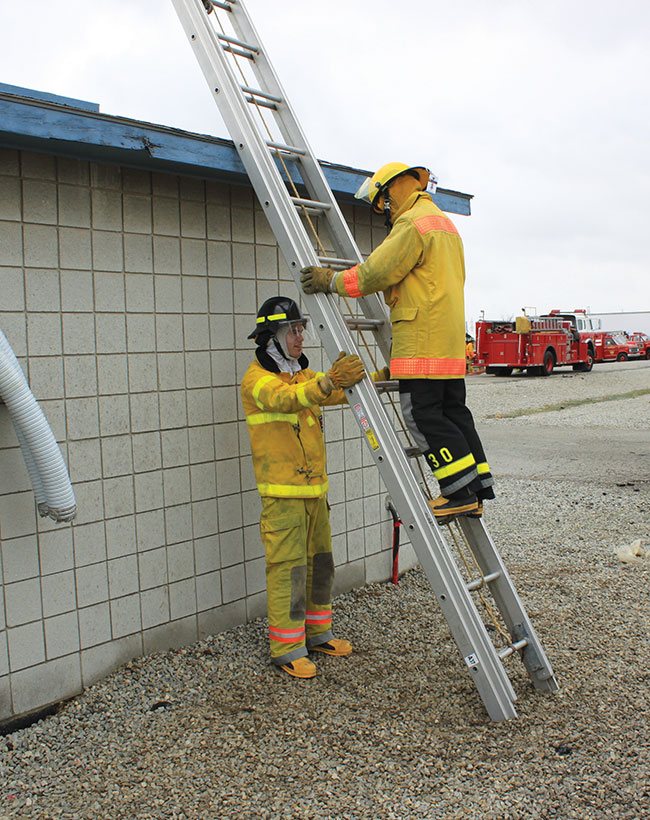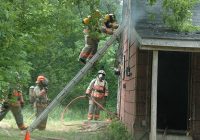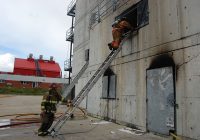
Equipment
Back to Basics: Ladder Dating – Heeling the Ladder
November 2, 2020
By
Mark van
 Photo 1: In most basic training classes, we see firefighters heeling the ladder from behind. Photos by Mark van der Feyst
Photo 1: In most basic training classes, we see firefighters heeling the ladder from behind. Photos by Mark van der Feyst
In our continuing look at ground ladders, heeling is one of those small but important factors of the ladder operation. It is common practice to heel a ground ladder whenever a firefighter is climbing up or down one. There are many ways to heel a ground ladder and this has led to a common debate within the fire service as to heel from the front or from the back of the ladder.
The fire service seems to gravitate towards heeling the ladder from the back. In most basic training classes, we see firefighters heeling the ladder from behind, as seen in Photo 1. Along with textbooks, instructors seem to use and teach this method commonly. The other ways to heel a ground ladder are to heel it from the front by using our foot against the beam at the butt or to have our foot on the bottom rung while standing in front of the ground ladder.
Why do we choose to always go behind the ground ladder to heel it? Why are we instructing our future firefighters to heel ground ladders from behind? While this may be an acceptable practice, it is quite dangerous.
Consider this scenario: two firefighters are using a 12-ft ground ladder to gain access to the roof of a garage. The one firefighter is heeling the ladder from the underside of it using both of his hands on the beam to hold the ladder from kicking out. The other firefighter then starts to climb up the ladder to the roof. The ladder has been set properly at the correct angle, it has three to five rungs above the roof line and yet the ladder kicks out and the firefighter falls to the ground. This happened just as the firefighter reached the top of the ladder. When he put his foot on the rung that rested just above the roof line, the firefighter that was heeling the ladder walked away, thus allowing the ladder to kick out.
When a firefighter heels a ground ladder from behind, they are unable to view the entire operation. They are only able to see the beginning stages of the operation, but not the end of it. This is the case in the scenario that I just described. The firefighter who was heeling the ground ladder from behind was able to see the beginning stages of the climbing operation but was unable to see the finishing stages of the climbing operation.
As soon as the firefighter who was climbing the ground ladder cleared the view of the heeling firefighter, the heeling firefighter walked away. What he did not see was that the climbing firefighter was only two rungs away from getting off the ladder and onto the roof. This was the cause of the ladder kicking out and the climbing firefighter falling with it. We are unable to look up all the way to view the entire operation. When we are wearing our full turn out gear, our SCBA and our helmet, we are restricted in our ability to look all the way directly up. For some, their helmet hits the top of the SCBA cylinder, for others the helmet blocks a part of their view with the front brim. Either way, the view of the operation is hindered and thus becomes a dangerous way of heeling a ground ladder.
Another aspect that is dangerous when heeling a ground ladder from behind is that we are exposing ourselves to falling hazards. Often, we are carrying up hand tools to help us with our assigned task. These hand tools fall. Gravity is working against us every time we are carrying up a hand tool. We get tired, lose our grip and our hand tool is now falling to the ground. Depending on how it is falling, there is an incredibly good chance that it will hit the head of the heeling firefighter. When we are breaking glass from a ground ladder, that glass falls right on top of the heeling firefighter. What will happen is that we want to see what is going on, so we look up. Have you ever heard an instructor tell you to not look up when you are heeling a ground ladder from behind? This is so that you will not have falling tools, broken glass, falling debris, etc., hitting your face. When you look up, you are exposing your neck, mouth, and eyes to whatever may be falling on you.
What if the firefighter climbing the ladder starts to slip or lose their balance while climbing? How quickly can the heeling firefighter come around from behind and stop the climbing firefighter from falling? Not very quickly! What if he needs assistance right away? Can the heeling firefighter assist him quickly from their position behind the ground ladder?
The best method to heel a ground ladder is from the front. By being in the front of the ground ladder, we can view the entire operation. We are also able to view the entire building. This allows us to constantly monitor the conditions and activities of the situation. Whether we are heeling the ground ladder with our foot against the beam at the butt or on the bottom rung, we are still accomplishing the same safety goal of preventing the ladder from kicking out. In Photo 2 and Photo 3, we can see this in action. From here, the heeling firefighter can view the entire operation from start to finish. They will also be out of the way of any falling debris.
The heeling firefighter in this position can also assist the climbing firefighter by preventing them from falling. The heeling firefighter can quickly climb up the ladder to pin or stop the climbing firefighter from falling off the ground ladder. This will work within distance of one section. If you have two or three sections of distance between the heeling firefighter and the climbing firefighter, you will not be able to reach them safely in time.
The next time you conduct ladder training, try to incorporate the front heeling method into your routine. Compare the two methods to see the differences and, hopefully, you will realize that heeling from the front will benefit you.
Mark van der Feyst has been in the fire service since 1999 and is currently a firefighter with the FGFD. He is an international instructor teaching in Canada, the United States, FDIC and India. He is a local level suppression instructor for the Pennsylvania State Fire Academy and the lead Author of Fire Engineering’s Residential Fire Rescue book and other DVD’s. He can be contacted at Mark@FireStarTraining.com.
Print this page
Advertisement
- Well Being: I am exhausted! Is this burnout?
- Leadership Forum: Covid concerns and positive solutions

